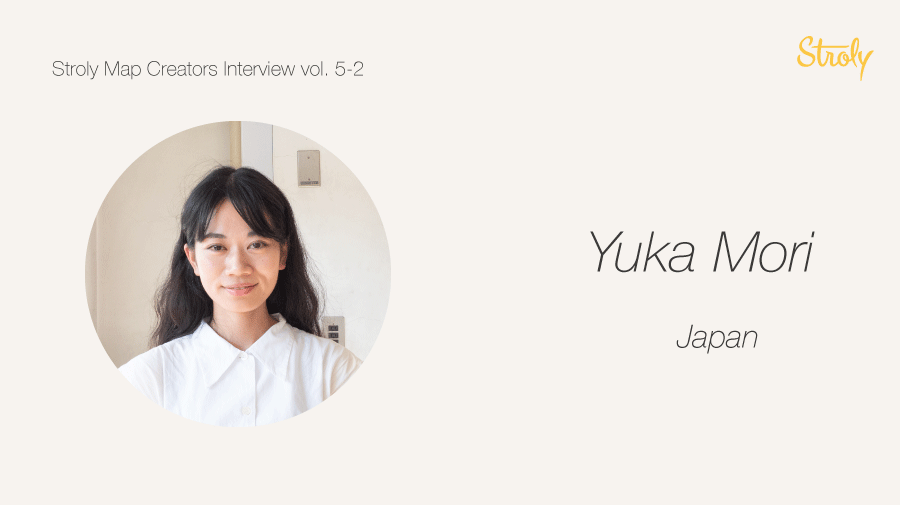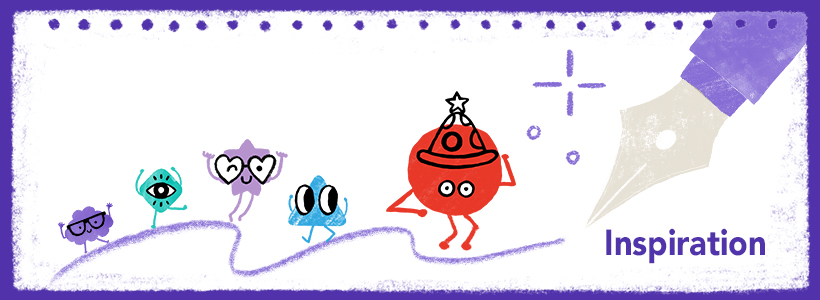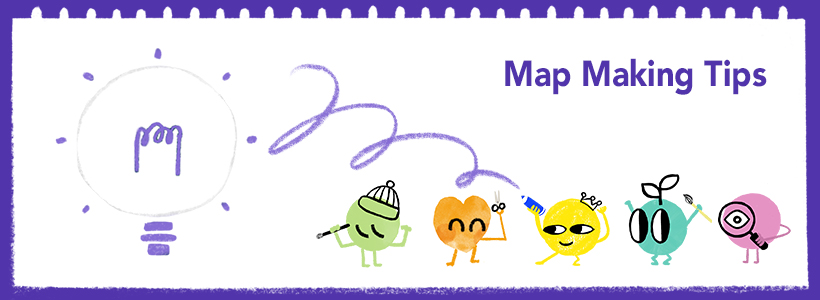The interview blog [Part 1] dug the roots of the artist, Ms.Moriyuka. Her story of getting inspiration from atmosphere, scent, and humidity left a great impression on me.
In the second part, I’d like to introduce to you her way of map-making. Let us explore more about Ms.Moriyuka!
[ A woodcut picture book is my reference book ]
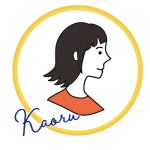
Including the work of “Fukakusa Inari town map”, do you have anything particular you always use when you create a map?
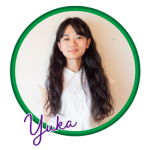
I do! I always take a look at a woodcut picture book of the Edo era featuring summer. I got this book from an exhibition.
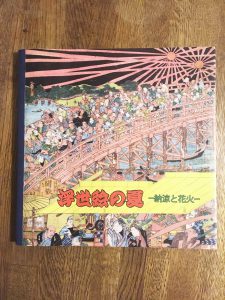
The front page of “Ukiyo-e no Natsu(Summer Ukiyo-e)”
As you know, I like to use frames when I add letters to my design. The book has a variety of examples, and I love them. For example, the way they draw Tanzaku(a strip of paper) or how they draw titles is really cool.
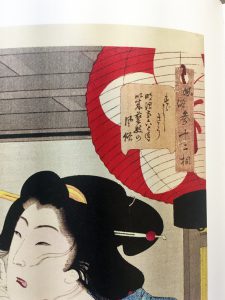
An example of frame design (Ukiyo-e Bijin-ga)
Most importantly, the book motivates me and makes my heart ponder especially when I see the refined lines of the woodcut pictures. For example, the way she holds a fan is so delicate and beautiful. I get excited to see this types of art.
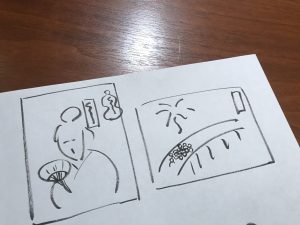
My heart races for the refined lines of a woman holding a fan
Here is a large long horizontal woodcut picture with a bridge in the middle and people in the size of rice-grain watching the fireworks.
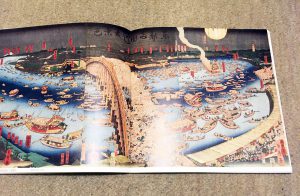
Isn’t it amazing that there was an artist in the past who made this with woodblock print? It also works as a self-discipline. I feel that I can’t complain about drawing some tiny details. I see it frequently to grasp the world view and get pumped up myself to get ready for creating a map.
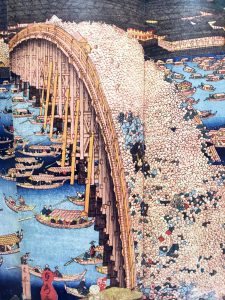
I also like the style of using colors. When I draw, I use the colors of Kimono or the Japanese traditional patterns as examples.
I don’t find many examples of maps in this book, instead, I found this historical map of Fushimi area useful to learn how to draw mountains.
 I know this map! The map using the perspective of viewing mountains from inside, right?
I know this map! The map using the perspective of viewing mountains from inside, right?
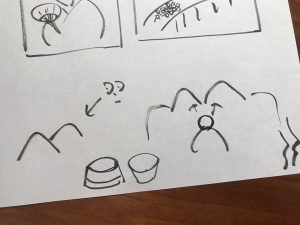
The perspective of viewing mountains from inside

Yes! Particularly this map introduced me to the idea that a map doesn’t always have to use one perspective to unify the image. Usually, I see maps drawn with a bird’s-eye view and using the perspective of looking down, but this has a residential area in the middle and uses the perspective of people looking up mountains around them.

Now, the mainstream of creating maps is using one perspective, and there should be a reason for that, but we can learn from this map that in the past, it was common to draw what you see as it is. We rarely see a map using this technique now, so it’s quite interesting, right?

Definitely! I’ve never seen a map like this, and I admire it. It even shocked me when I first saw it. They draw the objects so freely.

Historical maps are interesting because the way they grasp space is unique. When I see picture scrolls, I sometimes find interesting images that feature plane impressions but also include the 3D techniques depending on how you see them.
 I know what you mean. Sometimes I see a tub using totally opposite parse.
I know what you mean. Sometimes I see a tub using totally opposite parse.

I think they drew objects just the way they observed or felt. Or, they drew using the techniques they were capable of using at times. I feel their strong will power behind their drawings Lol.
 I admire the mindset, but maybe not the techniques Lol.
I admire the mindset, but maybe not the techniques Lol.
[The process of map-making]

How do you create an illustrated map? Could you explain the process? I ask that because depending on artists, the process of creating a map can vary. I’ve seen a case of a manga artist. He first completes the images of characters, then adds stories to them. So, I wonder how you proceed.

When I receive requests from Stroly to draw illustrated maps, they usually already have the purposes. So, when I draw a map, I first go for local coverage and decide the image or atmosphere of the map. Then I ask questions to myself; “How do I want to draw it?” “Do I want to use the traditional way of using ink?” “Do I want to express a bit of sensitivity to images?” “Do I want to use some frames?” or “What kind of paper do I want to use?”
 How about the process of creating character images?
How about the process of creating character images?

Actually I don’t focus too much on creating characters. I think I’m more interested in drawing buildings. If I include characters, I try to match my personality to them, or I follow a request from my client.
If I find a place where I want to include in the map, I will definitely do so. After that, I will start drawing a rough sketch on a piece of paper.

I was surprised at the level of completion of a rough sketch when we worked together with the “Fukakusa Inari town map”.
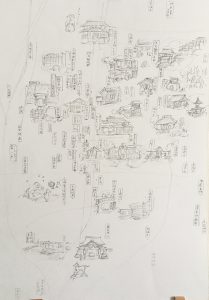
Fukakusa Inari Strolling map – a rough sketch

If I arrange each piece of information one by one, I feel like I’m losing the balance of the map. So, I draw illustrations without drafting them to grasp the big picture. I honestly think it’s not efficient because I need to adjust the size of the illustrations or the size of the paper after that.
Once I see roughly where each illustration belongs to, I start thinking of characters and locating them on the map.

I see. Then, you draft it, draw it with ink, color it, and adjust small parts, and complete the work, correct?

Exactly. I think hard during the process of a rough sketch, so the part you explained doesn’t require much of thinking. It’s more about ‘exercising’ for me.
 Right. Your daily illustrating exercise.
Right. Your daily illustrating exercise.

Correct Lol. The next map I will work on doesn’t require rough sketches, so I can start with drafting. Also, it seems they don’t have restrictions or rules, so I’m looking forward to it. I was like, “I can just do the best part and done!?”
[A character will be a rabbit if there’s no request]

Can you tell me more about how you create a character? If you have some requests, do you prepare a couple of examples to match them?
 Yes. If there’s no request, I usually use a rabbit.
Yes. If there’s no request, I usually use a rabbit.
 Why is it a rabbit?
Why is it a rabbit?

Because it’s easy to draw. When you draw a rabbit, it just needs the long ears, two eyes, and a nose. Here is what I think. When I draw a monkey, for example, I want to add a mouth to it. Because a mouth can add its characteristics vividly, it takes more time to complete it.
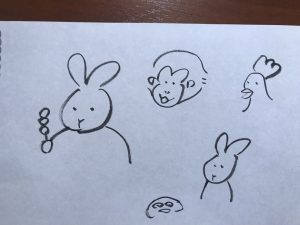
 It looks almost like drawing a human.
It looks almost like drawing a human.

Absolutely! I see drawing a monkey is close to drawing a human because I can also add hands to it. In the case of a rooster, the facial expressions depend on its mouth too.
But when I draw a rabbit, it completes the image without a mouth. Look, with a stick of sweet rice dumplings in his hand, the rabbit looks happy even though he has a stone-face. If I draw a rabbit looking at something odd, somehow I feel like the rabbit is saying “what the heck is this?”.
 With those illustrations, it makes total sense.
With those illustrations, it makes total sense.

It happens to, for example, Hello Kitty too. Because of the absence of expressions, it creates some space for readers to imagine what Hello Kitty is feeling. I draw a rabbit the most like a habit because it’s easy to use for any type of situation.
 Do you have a model for a character you draw?
Do you have a model for a character you draw?

Well, I project myself or a person I’ve gone a local coverage with to a character. I prefer not to set the personality. When I was drawing the Fukakusa Inari map, I recalled the time we went for research and imagined what Kaoru-san was saying. Then I project the images I have to the characters. Eventually, the character starts developing the personality by itself.

So, it starts from you and grows inside of you, then becomes a character close to you.

Yes, so I’d say drawing two fictional characters with totally different personalities is easy to imagine. For example, one character is full of energy and the other is calm and cool because I can create a series of conversations easily. I also like to think and be part of both personalities.
[I like to draw thin lines. I don’t like to draw a car.]

The next question is regarding the map of the One-day pass of the Keihan Railway. Many Stroly members wonder how you could create such an attractive and easy-to-understand map for a place that looks like a quiet rural area at first glance. Can you give us some tips?
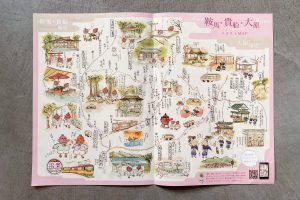
Illustrated map for Kurama, Kibune and Ohara (For a campaign/Distribution has ended) https://m.stroly.com/keychain/i#kurama
 I’m glad to hear that! May I ask you where exactly were they looking at when they made those comments? The mountains?
I’m glad to hear that! May I ask you where exactly were they looking at when they made those comments? The mountains?

Exactly. Mainly about the mountains. We were impressed by the way you created a small comment on each location and revealed the charms of the area.

That might have to do with the way I see the world. Without thinking, I have a habit of seeing an attractive place as an object to draw.
I can draw certain things well using ink, and I struggle with some. For example, I’m not good at drawing a car. I can draw it now, but I know I’d struggle with it. In contrast, I enjoy drawing old traditional Japanese houses. Especially the tiny details of them like the thin lines of bamboo blinds.
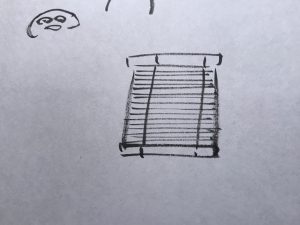
By adding many thin lines, the image can give you the impression of having much information. Also, I like to focus and enjoy the tension I get from drawing straight lines.
Speaking of the map of the Keihan Railway, there are definitely many illustrations that I loved and enjoyed drawing like the stairs of temples, the Kibune shrine itself, or the rooftops of Kawadoko(riverside summer terrace) that look like bamboo blinds.
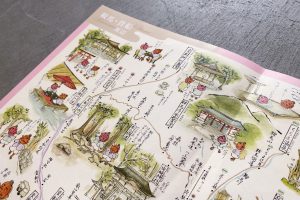
Illustrated map for Kurama, Kibune, Ohara(Campaign/Distribution has ended)
https://m.stroly.com/keihan/i#kurama
I love to draw stones too. When I have a chance to draw paving stones or stone walls, I feel so excited. On the other hand, cityscapes don’t excite me much.
 I see. I think your specialty matched well to the concept of the Keihan Railway map.
I see. I think your specialty matched well to the concept of the Keihan Railway map.
 Yes, I think that’s the reason why it looks charming.
Yes, I think that’s the reason why it looks charming.
 Just to get an idea, how long does it take for you to complete one illustrated map?
Just to get an idea, how long does it take for you to complete one illustrated map?

The part that takes time the most is creating a rough sketch or making corrections. The time I need depends on the clients I work for. To give you a rough image, I’d say one week in a maximum estimate. I’m quite fast to finish up once I start drawing with ink.
[I’m careful with a typo, colors, and the lightness of map]
 What do you think are the characters that represent your style?
What do you think are the characters that represent your style?
 It may sound very basic, but I’m careful with a typo. Especially if I can’t fix it later.
It may sound very basic, but I’m careful with a typo. Especially if I can’t fix it later.

It’s basic but really important, and requires a lot of focus.
I’ve also received many comments about your beautiful handwriting. Have you learned calligraphy?

Yes, I have! When I was in elementary school, in the first grade, my mom heard a rumor about a good calligraphy teacher in our neighborhood, and my mom, brother and I started going there. I loved the teacher, so it made me love calligraphy too. I’m not very good at it, but the experience of calligraphy could’ve been a root of me going to the path of Nihonga because both use ink. For some people, it could be bothersome to rub an ink stick or to use an ink brush to write or draw, but I didn’t mind that at all.

Now, I see everything you told me is connected. It may be too straightforward, but may I ask if you draft letters before you finishing up with ink?

No, I don’t because I like the feeling of a live performance. Of course, I think “Damn,
I can’t make mistakes!” and get nervous, but I feel like I can write better when I don’t prepare too much.
Besides that, I also try to organize colors and give lightness to my work.
I don’t necessarily use all my sense of color, but sometimes I can sense the balance of the colors is off when I look at my or someone else’s works.
“This color stands out too much” or “The balance of the colors is weird” etc…
So, I adjust the dynamic of colors at the end of the process by checking the whole picture.
 How about the lightness?
How about the lightness?

When I say lightness, I mean how active and how comfortable the images will be viewed by audiences. I think if I take too much time on one piece of illustration by fixing it many times, the illustration will somehow look heavy.
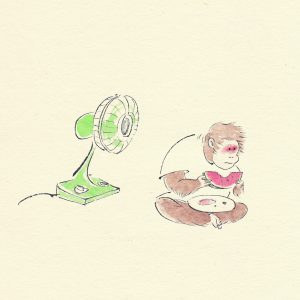
a fan
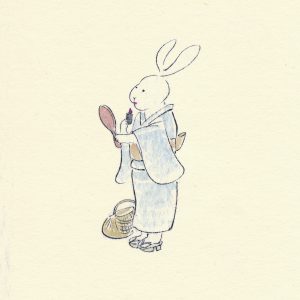
a lipstick

Personally, I feel like my eyes move fast when I see your illustrations because it makes me want to see more and more.
 Thank you. I want other audiences to feel in the same way.
Thank you. I want other audiences to feel in the same way.
[Take a close look at the details of my illustrated maps]
 What do you want readers to focus on when they see your maps?
What do you want readers to focus on when they see your maps?

The details. I don’t mean to force them to check every detail, but I try to draw objects close to the originals. For example, when I drew an illustration of a pickled vegetable shop in Kyoto, I truly depicted a barrel they use. I wasn’t expecting, but my friends also told me that they like seeing those details, so I’d be happy if users enjoy them too.
[Do you like to… draw?]
 This question can strike the heart of your belief, but let me ask… Do you like to draw?
This question can strike the heart of your belief, but let me ask… Do you like to draw?
 Yes! I enjoy it!
Yes! I enjoy it!
 I’m so glad to hear that…! During the process, when do you struggle the most?
I’m so glad to hear that…! During the process, when do you struggle the most?

I’d say the process of rough sketch. I don’t define it as a struggle, but when we hit a plateau and have to fix the rough sketch many times, I get frustrated and tired.
Also, the time when I can’t get emotionally attached to the characters! It never happened to the illustrated maps of Stroly, so don’t worry.
[My goal as a map artist]
 Is there any place you would like to draw in the future?
Is there any place you would like to draw in the future?

I’ve been drawing illustrated maps of Kyoto many times, so I’d like to challenge myself to draw buildings or places of foreign countries where have a completely different atmosphere. Also, I want to draw the foot of Mt. Hiei where I grew up. I think I can draw an illustrated map with full of love because only I can think of is a love for my hometown.

I think no matter where you pick in Japan, you will deliver a certain consistency of Japanese ambiance. Kyoto has many things that represent the ambiance.

Absolutely. I enjoy drawing things that represent Japan because they fit my style, but I think I can discover a new type of experience if I draw something not Japanese like… foreign food.
 Could you tell me what is your dream as a map artist?
Could you tell me what is your dream as a map artist?

I want to research an area by walking and eating around the specialties to make an illustrated map with me as a character.
There is an artist named, Hoshi Yoriko who draws a cat named “Nekomura-san”. In the magazine “Casa BRUTUS”, there is a page featuring Nekomura-san. He appears in some pictures and introduces an area. The idea of going to an unknown place, experiencing something new to create an illustrated map, and getting money for it excites me.
[The number of orders has been increased after working with Stroly]
 Is there any change after you started working with Stroly?
Is there any change after you started working with Stroly?

The number of orders has been increased after working with Stroly Lol. It’s true.
Besides requests from Stroly, I started to receive more inquiries. For example, I gave the illustrated map of the Keihan Railway map to a hair salon that I go to. The next day, an owner of a guest house saw my map at the hair salon and contacted me to ask if I can paint a mural on the wall of the guest house.
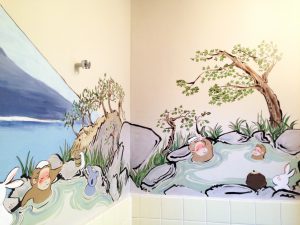
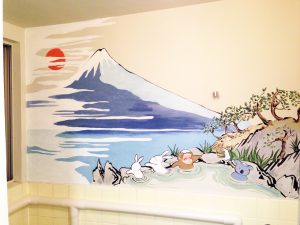
 I didn’t know that! I’m so happy for you.
I didn’t know that! I’m so happy for you.

I want to say thank you for Stroly because Stroly pays me the equivalent value of my work. I don’t have much experience, but staff members of Stroly introduce me as a “professional illustrator” as if I were a celebrity, and that makes me happy.
By hearing that, I can trust myself and get closer to the image. Also, by being treated professionally, I’ve developed a sense of responsibility, so I think and act accordingly. I’m grateful for the support.

No. Thank YOU! We treat artists with respect, and we don’t want to be rude by mistreating or disrespecting them. Including you, we admire all the creative artists.
We will keep working our best to support them.
 I’d do my best to respond to the support from you!
I’d do my best to respond to the support from you!
[Advice to new map artists]
 Do you have any advice to new map artists?
Do you have any advice to new map artists?

Just keep drawing maps! Some have told me, “I want to draw a map.”, “I want to be a professional picture book artist in the future.” But when I hear their stories, I often find out that they are not taking action toward their goals. They are not practicing to draw or they have never submitted their works to contests. Once you start to draw, you will see things that are missing or it can lead you to somewhere else. So, please keep drawing.
 Great advice. Do you have any message to Stroly?
Great advice. Do you have any message to Stroly?
 I’m glad that I can work with Stroly! You guys are the best! That’s all I want to say!
I’m glad that I can work with Stroly! You guys are the best! That’s all I want to say!
 Thank you so much for making time for us!
Thank you so much for making time for us!
・・・
Check follows for the latest information of Ms.Moriyuka!
Instagram、Website

